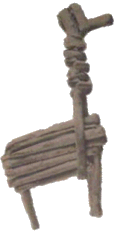|
Split Twig Figurines |
|---|


Photo courtesy of National Park Service |
Split twig figurines represent the oldest record of human occupancy of the Grand Canyon, some dating back over 4,000 years. Some of the effigies give the appearance of bighorn sheep and some that of mule deer, both animals still very common in the Grand Canyon today. The peoples that made these little animal effigies were part of the Desert Culture, the forebears of the Anasazi culture which occupied the Canyon after them.
Anthropologists suspect that the effigies were made as part of a ritual ceremony that was carried out before a hunt, to ask for the blessings of the animal's spirits before taking their lives.
The figurines were constructed by splitting willow twigs, using a stone blade, almost to the base of the twig. The two halves of the split twig were then wrapped and twisted around each other to construct the necessary shape. Sometimes the finished shape
was pierced with another piece of wood symbolizing that the animal had been struck by a spear or arrow, and killed. When the shapes were finished a torch made of juniper was lit, as part of the ceremony, and the shapes were placed beneath a cairn in the
back of a cave.
|
|
|---|
|
|---|